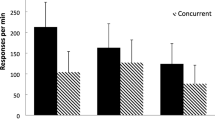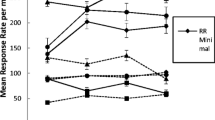Abstract
Operant laboratory studies were conducted as part of the regular activities of a psychiatric research ward. This report includes only some early data obtained from the ward staff, not the patients. A multiple schedule having alternating fixed-ratio and fixed-interval components permitted observations of acquisition and maintenance of behavior at low schedule values, transition to and final performance at greater schedule values, and behavioral changes after a limited-hold contingency was added to the fixed-interval. Prior to the added limited-hold, subjects used watches to time the interval, and usually responded only once before obtaining each fixed-interval reinforcement. Short limited-hold values eliminated clock watching and increased fixed-interval responding. Subjects communicated freely with each other, and it was clear that their performances were controlled both by the contingencies and by instructions. Just as clearly, the instructions themselves were controlled by the contingencies. It was concluded that the kinds of verbal control that were responsible for “nonstandard’’ fixed-interval performances did not require the postulation of any new behavioral principles.
Similar content being viewed by others
References
Artiss, K. L. (Ed.). (1959). The symptom as communication in schizophrenia. New York: Grune & Stratton.
Artiss, K. L. (1962). Milieu therapy in schizophrenia. New York: Grune & Stratton.
Bentall, R. P., Lowe, C. F., & Beasty, A. (1985). The role of verbal behavior in human learning: II. Developmental differences. Journal of the Experimental Analysis of Behavior, 43, 165–181.
Catania, A. C., Matthews, B. A., & Shimoff, E. (1982). Instructed versus shaped human verbal behavior: Interactions with nonverbal responding. Journal of the Experimental Analysis of Behavior, 38, 233–248.
Dinsmoor, J. A. (1983). Observing and conditioned reinforcement. The Behavioral and Brain Sciences, 6, 693–728.
Ferster, C. B., & Skinner, B. F. (1957). Schedules of reinforcement. New York: Appleton-Century-Crofts.
Harzem, P., Lowe, C. F., & Bagshaw, M. (1978). Verbal control in human operant behavior. Psychological Record, 28, 405–423.
Hayes, S. C., Brownstein, A. J., Zettle, R. D., Rosenfarb, I., & Korn, Z. (1986). Rule-governed behavior and sensitivity to changing consequences of responding. Journal of the Experimental Analysis of Behavior, 45, 237–256.
Holland, J. G. (1958). Human vigilance. Science, 128, 61–67.
Leander, J. D., Lippman, L. G., & Meyer, M. E. (1968). Fixed-interval performance as related to subjects’ verbalization of the reinforcement contingency. Psychological Record, 18, 469–474.
Lippman, L. G., & Meyer, M. E. (1967). Fixed-interval performance as related to instructions and to subjects’ verbalizations of the contingency. Psychonomic Science, 8, 135–136.
Lindsley, O. R. (1960). Characteristics of the behavior of chronic psychotics as revealed by free-operant conditioning methods. Diseases of the Nervous System Monograph Supplement, 21(2), 66–78.
Lowe, C. F. (1979). Determinants of human operant behavior. In M. D. Zeiler & P. Harzem (Eds.), Advances in analysis of behavior, Vol. 1: Reinforcement and the organisation of behaviour (pp. 159–192). Chichester, England: Wiley.
Lowe, C. F. (1983). Radical behaviorism and human psychology. In G. C. L. Davey (Ed.), Animal models of human behavior: Conceptual, evolutionary, and neurobiological perspectives (pp. 71–93). Chichester, England: Wiley.
Lowe, C. F., Harzem, P., & Bagshaw, M. (1978). Species differences in temporal control of behavior II: Human performance. Journal of the Experimental Analysis of Behavior, 29, 351–361.
Lowe, C. F., Harzem, P., & Hughes, S. (1978). Determinants of operant behavior in humans: Some differences from animals. Quarterly Journal of Experimental Psychology, 30, 373–386.
Schoenfeld, W. N., & Cumming, W. W. (1960). Studies in temporal classification of reinforcement schedules: Summary and projection. Proceedings of the National Academy of Sciences, 46, 753–758.
Sidman, M., & Stebbins, W. C. (1954). Satiation effects under fixed-ratio schedules of reinforcement. Journal of Comparative and Physiological Psychology, 47, 114–116.
Skinner, B. F. (1969). Contingencies of reinforcement: A theoretical analysis. New York: Appleton-Century-Crofts.
Skinner, B.F. (1957). Verbal behavior. New York: Appleton-Century-Crofts.
Weiner, H. (1969). Controlling human fixed-interval performance. Journal of the Experimental Analysis of Behavior, 12, 349–373.
Zeiler, M. D., & Kelley, C. A. (1969). Fixed-ratio and fixed-interval schedules of cartoon presentation. Journal of Experimental Child Psychology, 8, 306–313.
Author information
Authors and Affiliations
Additional information
This research was performed at the Walter Reed Army Institute of Research when all three authors were members of that Institute. The following colleagues and assistants greatly facilitated the conduct of the research: Kenneth L. Artiss, David McK. Rioch, Charlotte R. Rodman, Douglas Franc, and Nelson Yarborough. We also acknowledge the help of William J. McIlvane and Joanne Kledaras in preparing the manuscript. Reprints may be obtained from Lawrence T. Stoddard, Behavioral Neurology, E. K. Shriver Center, 200 Trapelo Road, Waltham, MA 02254; Murray Sidman, New England Center for Autism, 33 Turnpike Rd., Southborough, MA 01772; or Joseph V. Brady, Dept. of Psychiatry, Johns Hopkins School of Medicine, 730 Rutland Avenue, Baltimore, MD 21205.
Rights and permissions
About this article
Cite this article
Stoddard, L.T., Sidman, M. & Brady, J.V. Fixed-interval and fixed-ratio reinforcement schedules with human subjects. Analysis Verbal Behav 6, 33–44 (1988). https://doi.org/10.1007/BF03392827
Published:
Issue Date:
DOI: https://doi.org/10.1007/BF03392827




